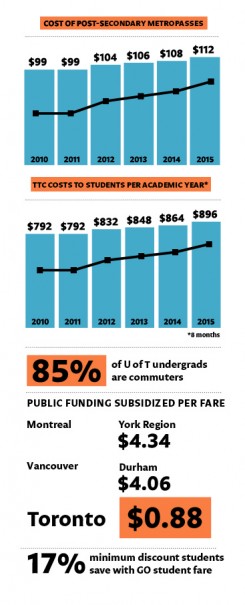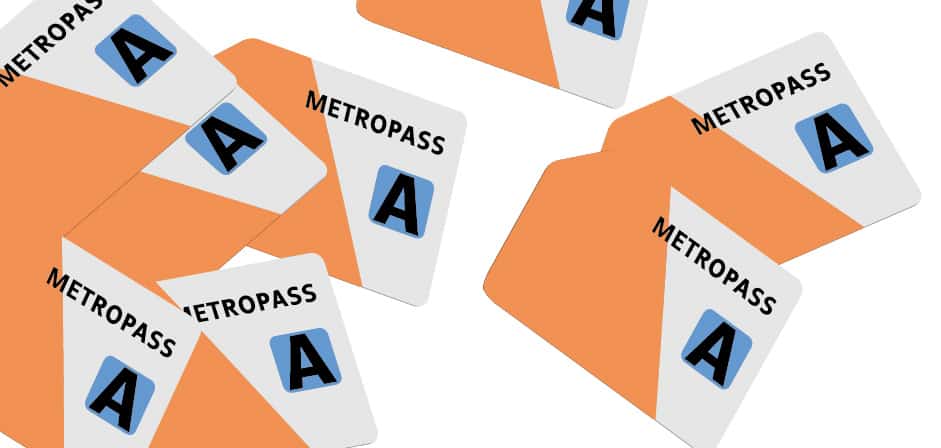Last week, mayor John Tory announced that Toronto Transit Commission (TTC) riders should expect a 10-cent increase in all non-cash fares in March of this year. The reasons for the change are painfully clear: our city’s transit system is dismal.
Anyone who has had the pleasure of riding the city’s streetcars, buses, or frequently delayed and overstuffed subway trains knows that walking or biking is often a preferable alternative — even in sub-zero weather. However, walking is not always a viable option for U of T’s commuter population — a group that has hovered around an estimated 85 per cent of students for years. While the increase in fares is frustrating, it is the glaring exclusion of post-secondary students from the conversation around transit that is most discouraging.
Currently, post-secondary students can purchase a discounted Metropass — an allocation first offered in 2010 — for $108 per month, making the total commute cost $864 for the months of September through April. Come March, the cost will increase to $112 monthly.
For students who travel to and from the St. George campus via Union Station, using GO Transit in addition to the TTC, the costs of commuting can amount to $25 per day. For students commuting five days a week, the aggregate cost is $550 per month and $4,400 for September through April.
 Due to the rising cost of living in the city, the expanding costs of commuting are being foisted on more and more students. In a CBC article, the shortage of low-income rental units in Toronto was described as “striking.” Many students are travelling further from campus in pursuit of affordable housing, necessitating the daily use of transit. Despite their growing financial burdens, there is no mention of considerations for post-secondary students in the justifications of the transit fare increase offered by the municipal government and the TTC.
Due to the rising cost of living in the city, the expanding costs of commuting are being foisted on more and more students. In a CBC article, the shortage of low-income rental units in Toronto was described as “striking.” Many students are travelling further from campus in pursuit of affordable housing, necessitating the daily use of transit. Despite their growing financial burdens, there is no mention of considerations for post-secondary students in the justifications of the transit fare increase offered by the municipal government and the TTC.
The TTC is not the only transit staple to announce a fare increase as of late. GO Transit also implemented an increase in the cost of their services effective February 1, 2014. This increase is proportional to the cost riders currently pay — determined by distance travelled — but will average to roughly five per cent.
Compared to other major North American hubs, Toronto and GTA transit riders’ fares cover 82 per cent of transit operation costs for the TTC and 72 per cent for GO Transit — the average farebox recovery ratio in the US sits at 36 per cent. The burden of this set-up is borne disproportionately by low-income constituents, which include students, who use public transit more frequently than wealthier citizens.
Some Ontario universities cover the cost of local transit for students. At McMaster University, for instance, students enjoy unlimited access to local transit for the academic year for $121.80 — a sum that is collected from their student fees. While it would be ideal to implement this system at U of T, commuting in a city struggling to afford transit improvements and attending an institution that spans three campuses and multiple transit systems makes unlimited access logistically unfeasible.
However, with 67,182 undergraduate students, the vast majority of whom are dependent on transit, U of T’s population is a sizeable market for the TTC. It is because the university represents a key consumer base that the shortfalls of the current system must be addressed.
The current savings from the purchase of a post-secondary Metropass are minimal for many students. If you travel on the TTC twice a day for 17 days per month — or roughly four days per week — cash fare costs $107, making the savings afforded by the metropass inconsequential unless you use transit more frequently. Further increases to Metropass costs while the cash fare remains frozen only increase the number of trips necessary to make the pass truly worthwhile.
Even when students commute often enough to justify the cost of the pass, the process to acquire it is woefully inaccessible. Post-secondary students are the only demographic who cannot access their discounted metropass with government issued photo ID. Instead, a TTC post-secondary student identification card must be procured for $5.25 at Sherbourne Station — an inconvenient location relative to many post-secondary institutions in the city.
During select dates in the fall term, students can have their ID made on campus through the University of Toronto Students’ Union. The ID card expires each year and must be replaced at cost. Only full-time students qualify for the pass.
GO Transit’s system is better in some respects. Students receive fares automatically discounted by at least 17 per cent with the presentation of a GO Student ID and the addition of the corresponding setting on their PRESTO card — though the discounts are only available to full-time students. The ID cards are readily available to students at TCard offices on all three campuses with the presentation of a TCard — the product of collaboration between the university and GO. A similar arrangement with the TTC would make the post-secondary student identification card more accessible.
There has been a lot of talk about Toronto’s lagging public transit infrastructure, and, of course, any progress is welcomed. However, as citizens of Toronto and as patrons of transit services, students should be considered and included in these conversations as significant stakeholders. We understand that some sacrifice is necessary to support the heavy costs of improving and expanding the city’s transit system. We are invested in the upgrading and development of the TTC — after all, roughly 85 per cent of us brave the over-burdened system each day.
It is clear that the transit systems in Toronto are broken and that time and money are needed to make large-scale changes to their infrastructure. However, small interim improvements would greatly benefit the lives of commuting students — among them greater access to the discount afforded by the post-secondary student identification card, and partnerships between GTA transit and the university to afford students more meaningful discounts. Paying for important infrastructure for Toronto’s future should not preclude us from affording our own.


